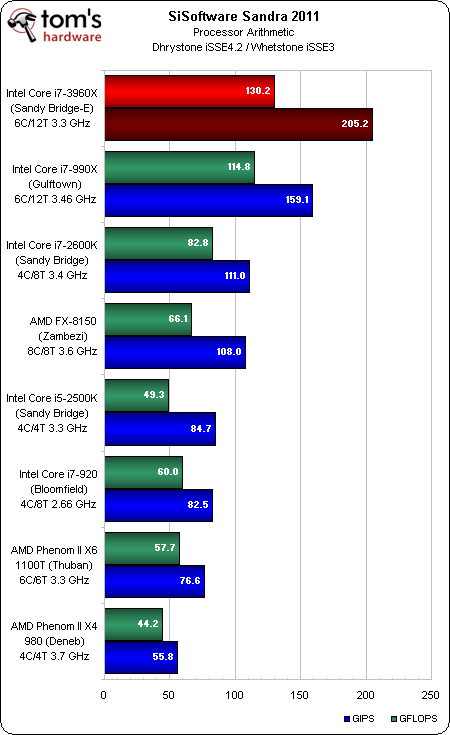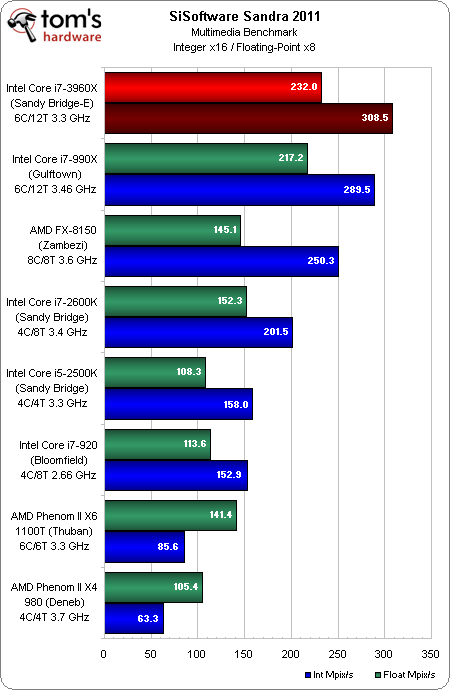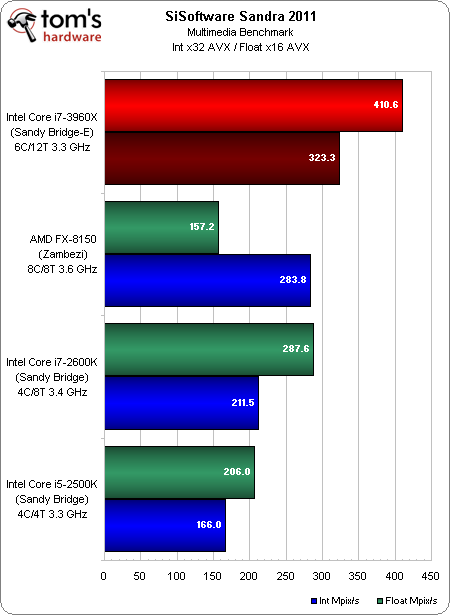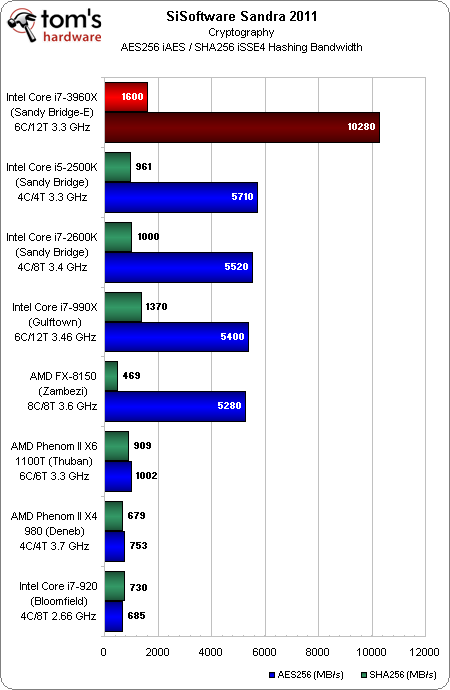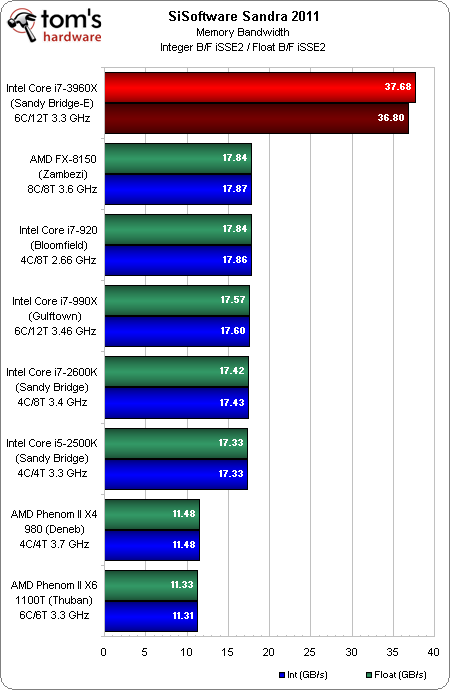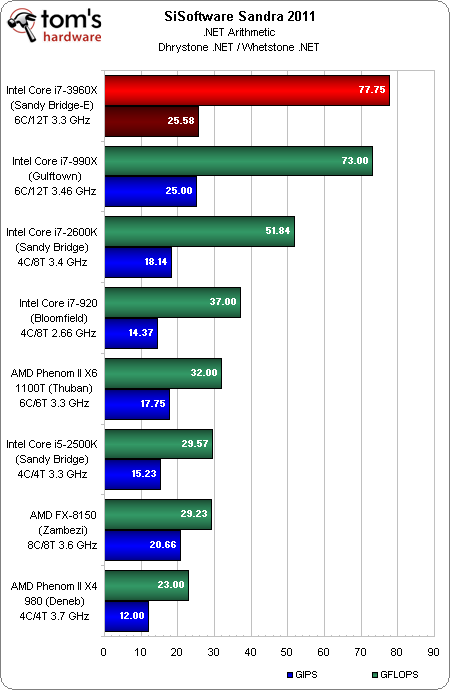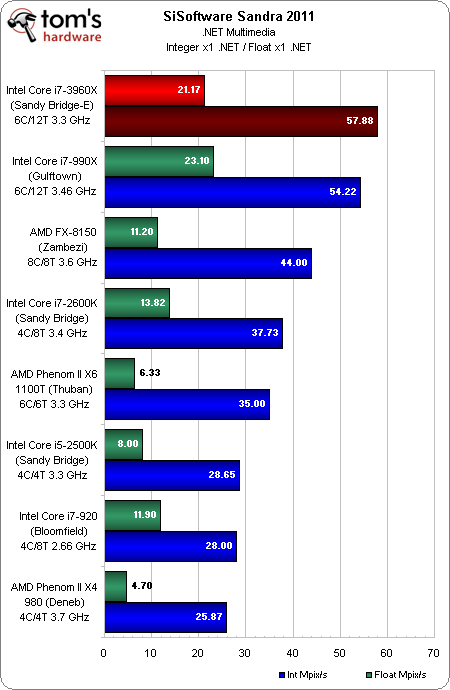Intel Core i7-3960X Review: Sandy Bridge-E And X79 Express
Intel's Sandy Bridge design impressed us nearly a year ago, but it was intended for mainstream customers. The company took its time readying the enthusiast version, Sandy Bridge-E. Now, the LGA 2011-based platform and its accompanying CPUs are ready.
Benchmark Results: Sandra 2011
Sandy Bridge-E has little trouble jumping to the top of the Arithmetic test, ahead of Intel’s outgoing -990X. Given Sandra 2011’s synthetic nature, it’s no surprise to see it exploiting all aspects of these eight processors.
Using SSE 4.1 (integer) and 2 (floating-point), Core i7-3960X slides right past Core i7-990X for the number one spot. Those figures improve dramatically with the implementation of AVX, though.
One of the things I noticed in Intel Core i7-3960X (Sandy Bridge-E) And X79 Platform Preview was that Sandy Bridge-E enabled significantly better AES256 bandwidth than Gulftown or Sandy Bridge. That advantage persists in the C1 stepping, nearly doubling Core i7-2600K’s result in the Cryptography benchmark. Intel confirms that it made changes to enhance AES throughput, but doesn’t expound on what it did.
Not satisfied, I did a little digging and started pulling memory modules. With three channels of memory, Sandy Bridge-E achieves 8 GB/s AES256 bandwidth. Two channels facilitate 5.43 GB/s. And a single channel of memory installed yields 2.72 GB/s. It seems that AES-NI is very much constrained by throughput (given that it's accelerated in hardware, and consequently very easy to execute), so it looks like the changes Intel suggested are tied to its memory controller, rather than its AES-NI implementation.
Hoping for some correlation to real-world performance (and a reason to get more excited about four 64-bit channels on the desktop), I ran a few tests in the latest stable build of TrueCrypt using the built-in benchmark and a 1 GB buffer. Despite a mean result of 3.8 GB/s in single-channel mode and 5.2 GB/s using two channels, performance fails to scale beyond that, indicating a bottleneck other than the speed at which the processor can encrypt and decrypt data.
The memory bandwidth advantage of a quad-channel DDR3-1600 bus is incredibly evident in Sandra 2011, which manages to realize around 37 GB/s from a potential 51.2 GB/s theoretical maximum.
Impressive though that number is, keep it in context. Sandy Bridge, with its dual-channel DDR3 memory controller, already showed that it wasn’t particularly starved for memory bandwidth in most desktop software. Practically, there won’t be many apps able to exploit those big throughput numbers. Perhaps that’ll change in the first quarter of next year when Sandy Bridge-E turns into Xeon E5 for dual-socket servers.
Get Tom's Hardware's best news and in-depth reviews, straight to your inbox.
Current page: Benchmark Results: Sandra 2011
Prev Page Benchmark Results: 3DMark 11 Next Page Benchmark Results: Content Creation-
SpadeM So no SAS/Full Sata 3 ports but u do get PCIe 3 ... no Quicksync but u do get 2 more cores and the added cache ... no USB 3.0 but u get quad channel memory which in real life every day computing is a minimal gain at best. Feels an awful lot like a weak trade if you ask me. I'm basically asked to buy the P67 chipset with sprinkles on top. And for 1000$ it feels like it falls short. For heavy workloads it's cheaper and faster to make yourself 2 systems based on 1155 or bulldozer and render, fold, chew numbers that way. X79 should have launched with an ivy bridge based cpu inside and a better chipset to live to it's name.Reply
What we have today is simply a platform for bragging rights not a serious contender to the X38, X48, X58 family. -
illfindu Not to take the review to much off topic but its worth bringing up because this review was so complete , as in covering a vast array of situations and programs. Its truly embarrassing for AMD that the FX-8XXX series is beaten not only bye chips with half the cores but half the cores that are a generation behind. In fact as of this moment the FX set is almost inspiring it its lack of any value at first glance at some of these marks one could say that AMD's most expensive chip at over 200$ is one of its slowest being beaten bye both the x4 and x6 phenoms.Reply -
redsunrises Illfindu, you are beating a dead horse... Old news, lets move on (sorry, just tired of the same thing being said over and over, which will end in an amd fanboy fight). Great review though!Reply -
ohim This article tells me 2 things , either our current software is a total piece of crap since it has absolutely no clue of multi core cpus, or the future without AMD is so grim that intel makes you pay 1000 bucks for a cpu that doesn`t perform really that fast ... but for sure the software industry needs to take a better look at those multicore optimisations.Reply -
stonedatheist I think Intel would be raking in the dough if they left all 8 cores enabled for the 3960X. I doubt that a later revision will enable them. 8c/16t will probably hit the desktop with IB-E (can't wait) :)Reply -
joytech22 :| Well AMD is fighting a losing battle.. (In High-End CPU's, which I actually use for rendering etc..)Reply
I would LOVE to see them pick up their game and provide me with a worthy upgrade over my 4GHz i7 2600 (Non-K). I would swoop it up.
Look, BD had 4 modules with two "cores" each, each module is equivalent to a Sandy Bridge core.
They should just combine both of those cores or make them a single core, so we get 4 threads.
Then create 4-6-8 core versions of those CPU's..
Think about it.. the FX8150 is more of a 4-core CPU where the resources are halved pretty much so you get two threads per core, it would have been MUCH MUCH better if they just kept 4 strong cores.
Not sure why either but I always seem to start an AMD related comment :\ -
JeanLuc Hi Chris,Reply
The labels are wrong on the graphs on this page the last ones should read DDR2-2133 on the last two shouldn't it?
JeanLuc
